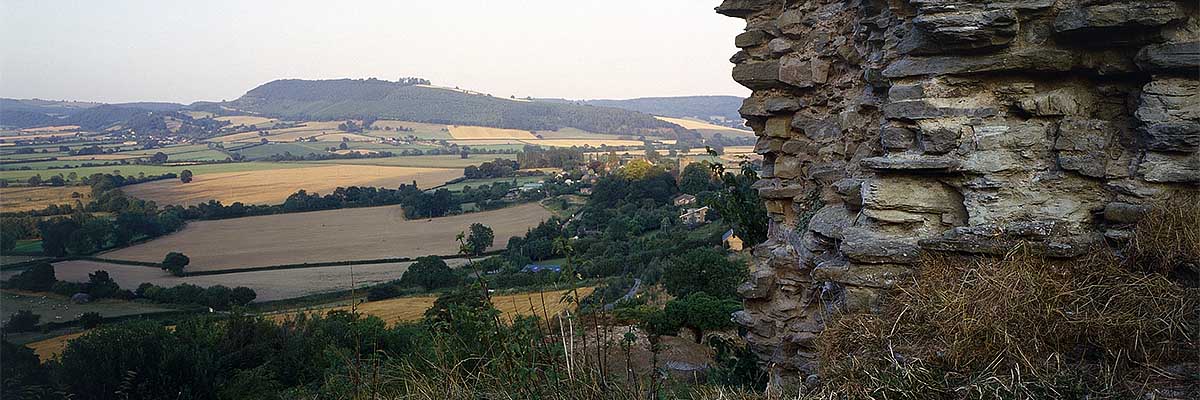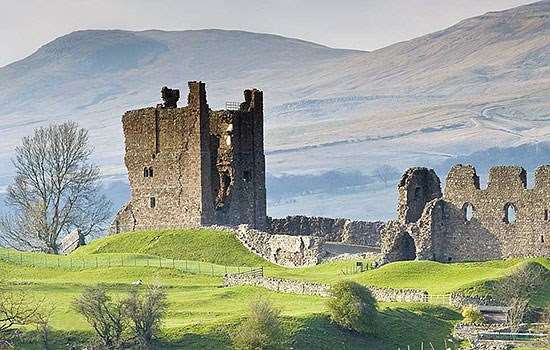History of Wigmore Castle
Wigmore was one of many castles built close to the England–Wales border after the Norman Conquest. Founded in 1067 by William Fitz Osbern, it was a major centre of power for over 500 years, and played host to several kings and queens. It was held by the Mortimer family from about 1075 to 1425, when it passed to the Crown. The castle fell into ruin after the Civil War and remained an untouched ruin until the 1990s, when English Heritage conserved it in a way that ensured the castle’s natural environment was preserved.

The First Castle
The castle was founded in 1067 by William fitz Osbern, Earl of Hereford and a close associate of William the Conqueror. It was sited close to the border between England and Wales, one of a series of castles designed by the Normans to defend England against attack by the Welsh. The original Norman castle at Wigmore had reinforced timber walls on top of large earthworks.
The Mortimers’ Castle
After fitz Osbern’s death in 1071 the castle passed to the Mortimer family, who held it until the early 15th century. They rebuilt the castle in stone in the 12th and early 13th centuries. The inner part of the gatehouse and the D-shaped east tower are the main survivals from this period.
Wigmore became the chief fortress from which the Mortimers controlled large parts of central Wales. It served as their base for numerous military incursions into Wales, and was besieged in 1155 and perhaps also in 1264.
Lords of the Welsh March like the Mortimers had many special privileges, including the right to make war, to hold courts, and to receive certain revenues otherwise reserved for the king of England.
In the early 14th century Roger Mortimer, 1st Earl of March (1287–1330), added more towers to create high-status lodgings with fireplaces and window seats. He also added a large porch to the gatehouse. Further works were carried out in the 15th century.
The Earls of March
Roger Mortimer is perhaps the family’s best-known figure. He became virtual ruler of England after he and his lover, Isabella, Edward II’s estranged queen, had engineered the king’s deposition and murder in 1327.
In 1329 Mortimer held a lavish tournament at Wigmore, attended by the young King Edward III and his mother. His influence was shortlived, however: in 1330 Edward III asserted his authority, arrested Mortimer and had him executed for treason.
After Mortimer’s execution the castle was returned to the Mortimers in the later 14th century, although it never regained its earlier importance. Ludlow seems to have become their main residence. Roger’s heir, Roger Mortimer (1328–60), 2nd Earl of March, was a founder member of the Knights of the Garter and his grandson the 4th earl, another Roger Mortimer (1374–98), was briefly heir presumptive to the English throne.
Wigmore in the Civil War
During the Civil War the Parliamentarian Harleys were unable to defend both Wigmore and their main home at Brampton Bryan, so they appear to have demolished parts of Wigmore to prevent its use as a base by the Royalists.
Brilliana Harley, the wife of Sir Robert Harley (1579–1656), whose father bought Wigmore from the Crown in 1601, successfully withstood a Royalist siege at Brampton Bryan in the spring of 1643 but the house was eventually destroyed following a second siege in 1644.
After the Civil War several centuries of neglect ensued at Wigmore, leaving the medieval castle remarkably undisturbed.
A Glorious Ruin
Wigmore now has an overgrown appearance that once characterised many ruined sites.
When conserving the site in the 1990s, English Heritage deliberately retained its wildness, as the castle had become home to rare and unusual species including lesser horseshoe bats and wildflowers such as ploughman’s spikenard. Accumulated debris was allowed to remain, and the grasses, ferns and flowers growing on the walls were carefully lifted up and replaced as ‘soft-capping’ to protect the walls from rain and more destructive plants like trees.
The conservation works also included two archaeological excavations. These revealed that as well as the towers along the curtain wall, there were timber-framed buildings all along the inside of the inner bailey.
Further Reading
Brown, G, An Earthwork Survey and Investigation of Wigmore Castle, Herefordshire, English Heritage Archaeological Investigation Report (2002)
Coppack, G, ‘Setting and structure: the conservation of Wigmore Castle’, in Managing Historic Sites and Buildings, ed G Chitty and D Baker (London, 1999) 61–70
Remfry, PM, The Mortimers of Wigmore, Part 1: Wigmore Castle 1066–1181 (Worcester, 1995)
Remfry, PM, Wigmore Castle Tourist Guide (Worcester, 2000)


